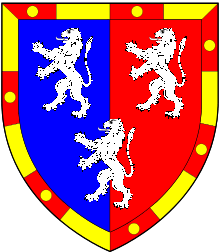Richard Herbert (died 1510)
Sir Richard Herbert Kt (died 1510) of Ewyas, Herefordshire, was a Welsh knight, gentleman, landowner, and courtier. He was an illegitimate son of William Herbert, 1st Earl of Pembroke (1423–1469), and Maud ap Howell Graunt, a daughter of Adam ap Howell Graunt (Gwynn).[2][3][4] Richard had a full brother named George.[4]
- For other people of this name, see Richard Herbert.
Richard Herbert | |
|---|---|
_-_geograph.org.uk_-_710352.jpg) The tomb of Sir Richard Herbert of Ewyas (died 1510) | |
| Died | between 2 and 12 September 1510 |
| Nationality | Welsh |
| Occupation | Knight, Gentleman, Courtier |
| Title | Sir |
| Spouse(s) | Margaret Cradock |
| Children | Three, including William Herbert, 1st Earl of Pembroke |
| Parent(s) | William Herbert, 1st Earl of Pembroke Maud ap Howell Graunt (Gwynn) |

Richard Herbert of Ewyas should not be confused with his uncle, Sir Richard Herbert of Coldbrook.[5]
Herbert legacy
The titles and estates of the Earl of Pembroke descended to Herbert's younger, legitimate half-brother William,[4] but he achieved notability through his own merit and through his descendants: "Sir Richard Herbert, of Ewyas, who, though illegitimate, is ancestor of the men who have really, in modern times, rendered the name of Herbert illustrious."[6]
In 1465, Richard Herbert was granted Westminster, manors of Grove, Radnore, Mookas, Brutescourt, Throuckeston, Westhide, Egelton, Redehire, Howton and Wormeton Tirell, in Herefordshire.[7]
He was successful as a Gentleman Usher to King Henry VII and was appointed Constable and Porter of Abergavenny Castle on 22 July 1509.[4][5] While Herbert is most often named as "Sir Richard Herbert," there is uncertainty as to whether he was knighted. In "The Knights of England", there is a record of a Richard Herbert being knighted in 1513, but that was three years after this man's death.[8] According to Sil, Richard was never knighted, but was an Esquire.[4] Richard is entitled Esquire in 1465, when he was granted manors and lands.[7] However, other sources[2][3][5][6] call him "Sir Richard Herbert", and an article entitled "The Family of Herbert" in The Gentleman's Magazine states that he was knighted by King Henry VIII,[9] in which case as he died in 1510 he would have been knighted in the last year of his life, and the first year of Henry VIII's reign, which began in 1509.
Marriage
Richard married Margaret, a daughter of Sir Matthew Cradock of Swansea and of Alice (or Jane) Mancell, widow of John Malefant.[2] Sir Matthew Cradock was receiver of Glamorgan,[4] through whom Castleston Castle passed to his daughter Margaret and Richard Herbert.[10]
Issue
Richard and Margaret Herbert had three surviving sons, one of whom was William Herbert, 1st Earl of Pembroke (1501–1570), who was created Earl of Pembroke (of the second creation)[6] on 11 October 1551.[4] Later Earls of Pembroke[3] and Montgomery, and of Carnarvon, and the Dukes of Powis, of Pool Castle (extinct 1747), descend from Sir Richard Herbert. Through a female line the Marquis of Bute derives his Glamorganshire estates.[6] Herbert's son William married Anne Parr, sister of Queen Catherine Parr, the sixth and last wife of Henry VIII. William served Henry VIII in many capacities, including Chief Gentleman of the Privy Chamber, Privy Councillor, and Receiver of the King's revenues. He was knighted in 1544 and later appointed a Knight of the Garter.[5] Another son was Sir George Herbert of Swansea,[11] who was ancestor of the Herberts of Swansea, Cogan, Cookham, and the White Friars, who became extinct in 1739. Candleston Castle passed from Richard and Margaret to their son George.[10]
Richard was also the father of the illegitimate Herberts of Dinas Powis and Hengastell.[12]
Death
Richard Herbert died between 2 and 12 September 1510 and was buried in Abergavenny Church; his tomb has a lavishly decorated wall arch and an alabaster effigy.[2][13]
References
- A.P. Shaw, "The Heraldic Stained Glass at Hassop Hall, co. Derby", Part I, published in Journal of the Derbyshire Archeological and Natural History Society; (Derbyshire Archaeological Journal), Volume 31, 1909, pp.191-220, esp. pp.203-207) (Source:
- Lee, Sidney, ed. (1885–1900). . Dictionary of National Biography. 220. London: Smith, Elder & Co. p. 220.
- John Burke (1831). A General and Heraldic Dictionary of the Peerages of England, Ireland, and Scotland. London: Henry Colburn and Richard Bentley. pp. 259–260. OCLC 4645457.
- Narasingha Prosad Sil (2001). Tudor Placemen and Statesmen: Select Case Histories. Madison [NJ], London, Cranbury, [NJ]: Fairleigh Dickinson University Press, Associated University Presses. p. 95. ISBN 0-8386-3912-7.
- Sanford, John Langton; Townsend, Meredith (2004) [1865]. The Great Governing Families of England. 2. Adamant Media Corporation. pp. 171–173. ISBN 1-4212-7842-1.
- "Some Notice of William Herbert, First Earl of Pembroke of the Present Creation". Wiltshire Archaeological and Natural History Magazine. Wiltshire Archaeological and Natural History Society. 17–18: 83. 1878.
- Great Britain Public Record Office. Calendar of the patent rolls preserved in the Public record office. p. 7.
- Shaw, W (1906). The knights of England; a complete record from the earliest time to the present day of the knights of all the orders of chivalry in England, Scotland, and Ireland, and of knights bachelors; Incorporating a complete list of knights bachelors dubbed in Ireland, compiled by G. D. Burtchaell. London: Printed and published for the Central chancery of the orders of knighthood, Sherratt and Hughes.
- Sylvanus Urban, ed. (1845). "The Family of Herbert". The Gentleman's Magazine. London: John Moyer Nichols & Sons. 178: 596.
- Spurgeon, C (2000). An inventory of the Ancient Monuments in Glamorgan. 3. Royal Commission on the Ancient and Historical Monuments of Wales. p. 409.
- Malcolmson, C (1999). Heart-work: George Herbert and the Protestant ethic. Stanford, CA USA: Stanford University Press. p. 16.
- Nichols, J, ed. (1863). The Herald and Genealogist. 1. London: John Boyer Nichols and Sons. p. 34.
- Jeremy Bolwell (2008). "The tomb of Sir Richard Herbert of Ewyas". Retrieved 9 February 2011.